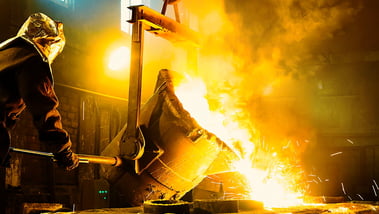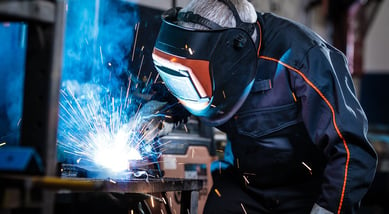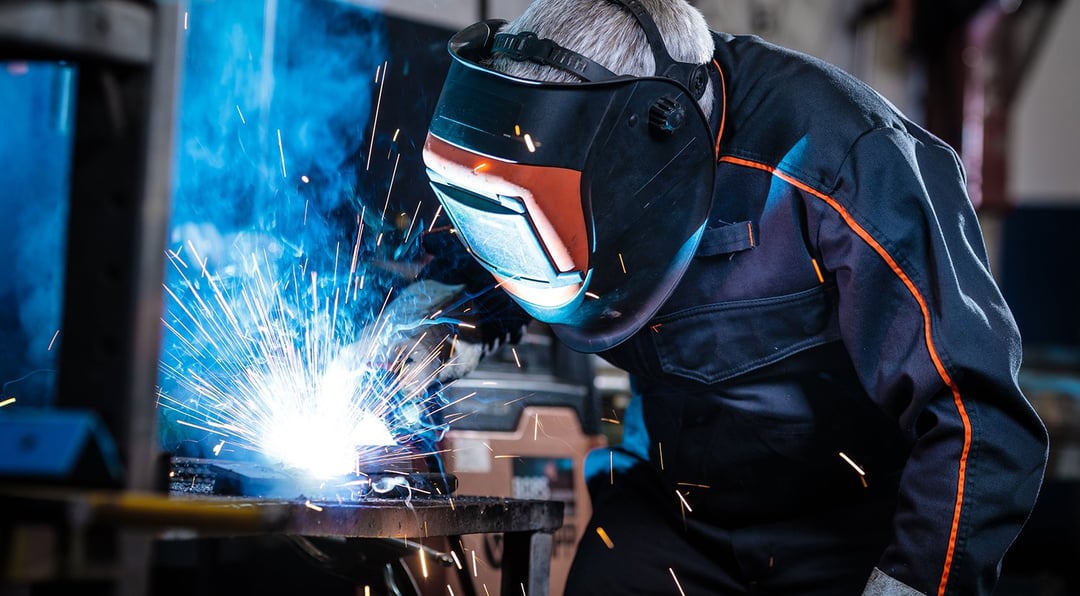The steel and metal industry is roughly divided into two main categories, each with its own unique set of risks — and norms. The categories are:
- steel and metal production
- steel and metal processing
As you can imagine, working in a steel foundry represents different risks than working in shipbuilding or machine construction. In steel production (ie. Tata Steel, US Steel), you deal with high temperatures, the risk of molten metal splash, and flammable gas formation, while in steel processing (ie. Damen Shipyards, Stork), the risks are related to the high amount of welding done to fuse plates of steel together.
 |
 |
#1: EN ISO 11612
The EN ISO 11612 norm consists of several tests that simulate different FR risks. To meet the EN ISO 11612 standard, the protective fabric needs to pass at least two tests: the A test and at least one of the B, C, D or E test. The performance of the fabric is tested on:
- Test A: flame spread
- Test B: convective heat
- Test C: radiant heat
- Test D/E: molten metal
- Test F: contact heat
The test results are classified into ‘performance levels’. Performance level 1, for example, indicates that the fabric provides the minimum protection to pass the test. If you’re responsible for your company’s protective clothing, it’s advisable not only to look at whether a fabric has passed the EN 11612 norm, but also to which degree.
It’s critical to understand the different performance levels of this norm, because they are related to the size of the risk impact. The three performance levels in the E test for example, tell you something about the protection against different amounts of molten iron splash: E1 stands for 60g to <120g molten iron splash and E3 for >200g. Depending on the risk levels of your work environment, you need to choose the right performance level. If you’re facing challenges in translating lab results into real life protection, read these practical insights into the EN ISO 11612 norm for the steel and metal industry.
#2: EN ISO 11611
In the steel and metal processing industry, this norm specifies the minimum safety requirements for protective clothing for welding and allied processes. Protective clothing with the EN ISO 11611 norm protects the wearer all day against molten metal sparks and accidental flame contact. For special welding operations, you need to make sure you meet class 2 protection, as we explain below.
The EN ISO 11611 norm consists of four tests which simulate different FR risks:
- radiant heat (ISO 6942)
- molten metal (ISO 9150)
- flame spread (ISO 15025)
- electrical resistance (EN 1149-2)
It’s also important to note that EN ISO 11611 is segmented into two classes. If all of the above tests are passed, you achieve class 1. If for the test ISO 6942 and ISO 9150 both class 2 requirements are obtained, class 2 can be claimed.
Which class applies to me?
It’s crucial that you’re aware of the differences to determine whether your protective clothing should comply with class 1 or class 2. Gas welding is a class 1 welding activity, while MMA welding (with basic or cellulose-covered electrode), MAG (with CO2 or mixed gasses) and MIG (with high current) welding are all class 2 welding activities.
#3: IEC 61482-1-2
This norm is the European standard protecting workers from electric arc in the event of an electric fault during electrotechnical work at or near live parts (for instance, repairing the switch box of a processing machine that consumes high amounts of electricity, such as a melting pot). An electric arc flash is a fireball explosion that can cause fatal accidents if the right protective clothing isn’t worn.
#4: EN ISO 20471
This norm is the international standard for high-visibility clothing. When you move around a lot on the job, you’re more exposed to hazards. This makes visibility at night or in darker working conditions a safety essential. We’ve noticed steel and metal workers increasingly using high visibility ‘elements’ (no full compliance to EN20471 – level 1) to provide enhanced visibility.
#5: EN 1149
This norm is the European standard specifying the electrostatic properties of protective workwear. Anti-static material will prevent sparks caused by friction, keeping workers protected from potential explosions of flammable gasses or substances. Certain companies - or workstations (e.g. spraying activities) - in the metal and steel industry make use of (volatile) organic compounds and substances that can cause such risks.
#6: EN 13034
This norm is the European standard reviewing protective clothing on its performance to limited chemical splashes. Although this norm is not very commonly used in the industry, certain workstations or niche companies deal with hazardous chemicals that are stocked and processed. For example, galvanic companies that treat surfaces may use chemicals based on strong acids.
Which norms apply to me?
How do you identify the norms which apply specifically to you? Two words: risk assessment! A risk assessment allows you to make an inventory of the current risks in your unique work environment in detail. Let’s say you’ve identified your specific risks with a risk assessment. Now you’ll be able to match those risks to corresponding norms for safety compliance.
Needless to say, safety goes beyond compliance. There are basic requirements in protective workwear that you must comply with, but these can vary according to the unique work environment of your company. Many H&S Managers may not realize that norm specifications represent the minimum safety required. This means that some low-quality protective fabrics may pass the norm tests, but not protect your workers sufficiently from the real-life hazards they face on the job. Conducting lab and field tests can help you understand the difference in quality between fabric options – even when all options comply with norms on paper.
Don’t take norms at face value
With so many things to consider, it’s easy for a H&S Manager to focus on the wrong norms. While certain risks are clearly covered by the norms we’ve mentioned in this blog, there are some blurred areas. Grinding resistance, for instance, isn’t specified in the EN ISO 11611 welding norm. Another example is the lack of specific norm tests for different metals. While aluminium falls under the norm, metals such as zinc and copper do not.
That’s why it’s important to stay vigilant, go beyond compliance and test your options yourself. Take a grinding machine and test it on your fabric in a field test, for instance. Or test zinc on your fabric. At the end of the day, it’s your responsibility to be realistic about how far the norms go, then take measures to protect your workers on top of the norms.
Get specific for the best protection
While identifying your company’s specific safety requirements, don’t forget other important criteria such as the wearer’s comfort, fabric softness, durability, sustainability, and corporate image. Norms and primary selection criteria don't cover these “secondary” elements! It’s all well and good if your protective workwear ticks off all the norms when it comes to compliance, but what if no one wants to wear it safely because it feels itchy, hot, or doesn’t sit right? Comfortable protective garments are the key to steel and metal safety.
Finally, when selecting steel and metal protective workwear it’s smart to start with a clear picture of your risks — not necessarily with a shopping list of the norms you think you need. More norms or a multi-norm solution isn’t always better; the widest solution isn’t always the best solution. Don’t just launch a tender with old, unverified specifications copy-pasted from your last tender. Instead, perform a thorough risk assessment and come to your supplier with your specific needs, so they can help you find the best solution.
Want to go beyond compliance to build a strong safety culture in your company? Learn more in our 6 Industry Trends report below.
![6 Industry trends [EN]](https://eu.tencatefabrics.com/hs-fs/hubfs/EU%20-%20Images%20website/EU%20-%20Mock-up%20nieuwe%20afmetingen/6%20Industry%20trends%20%5BEN%5D.png?width=170&name=6%20Industry%20trends%20%5BEN%5D.png)
Read our trend report
Learn about 6 important industry trends and improve the safety and comfort of your protective clothing:






.png?width=399&name=Risk%20management%20for%20PPE%20clothing%20in%20the%20EV%20and%20battery%20industries%20(5).png)
